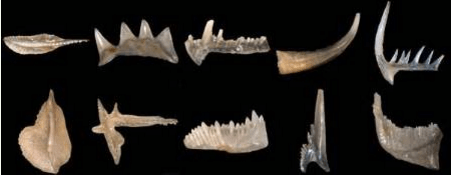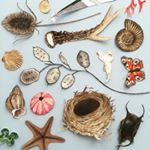Have you been to The Natural History Museum in London?
It is my favourite museum and last week I went into a part of the building where I’ve never been before.
This is the part where there are microscopes and labs, and piles and piles of books, boxes of stones and bags of bones and hundreds of fascinating things all collected from the air, the earth, and the sea.
I was allowed in to meet a scientist called Giles Miller, I wanted to talk to him about what kind of science I might do on my Arctic Adventure.
Giles is a micropalaeontologist.
Micro palae ont ologist, which means…
Micro = small, it actually means one millionth. As in microscope, microchip, micropig etc.
Palaeontologist = Someone who studies fossils.
This makes Giles Miller a scientist who studies tiny fossils. And the tiny fossils that Giles is interested in are called conodonts and they are worms teeth!
Microscopic. Fossilised. Worms teeth.

Giles showed me a picture of these worms teeth called conodonts and said that maybe I could find some of them in Svalbard, which is where I’m going in the arctic circle, quite near the north pole.
This picture is taken through a powerful microscope, in real life they are less than a millimetre long.
I thought that looking for conodonts in Svalbard might be like looking for a needle in a haystack.
What actually are conodonts?
Conodonts are the teeth of little worms that swam around in the sea millions of years ago. When the worms died their soft bodies rotted away but their teeth were left on the bottom of the sea. Loads of other bits and pieces fell on top of them and eventually these bits turned into stone with the worm teeth fossilised inside.
If we can find some of this stone and dissolve it away we can get the fossilised worms teeth out and look at them.
The conodont worms lived 500 – 205 million years ago, between the Cambrian and the Triassic ages.
Giles showed me a special map of Svalbard. This map shows the different ages of rock in different colours, blue for Cambrian and purple for Triassic.

I am going to be staying in a hut where the black arrow is pointing and the good area for finding conodonts is where the red arrow is pointing. Only about 20 miles away.
So, all I would have to do is somehow get myself to a place called Kapp Belvedere (red arrow), collect the right sort of rocks, bring them back to the Natural History Museum, dissolve them in acid, and see if they have any fossilised worms teeth inside.
Simple right?
Well I thought it would be worth a try.
So I emailed the governor of Svalbard to ask her if I am allowed to collect some rocks and bring them back to England. We’ll see what she says.
You can find out more about conodonts on Giles’s blog here.
UPDATE. June 8th 2017
Dr Ian C. Harding has written in to give us some more information on Conodonts. Ian is Associate Professor of Palaeontology at the University of Southampton and an expert on these matters.
He says of the fossils I am searching for, “They have for some years now been viewed as chordate teeth, belonging to beasties somewhere between cephalochordates like the Lancelet, the agnathan lampreys & hagfish and the ostracoderms (armoured fish).”
Have a look at Hagfish on the internet – they are quite interesting!

Microscopic, fossilised worms teeth!!!!! WOWoWOW. Good luck with the hunt!
LikeLike
It would be quite exciting if I found one! We have to wait and see whether the Governor will permit the search.
LikeLike
Cor! That’s good stuff xxx
LikeLike
Glad you think so! xx
LikeLike
Those teeth look good and vicious, are there any toothy worms around today?
LikeLike
Hello Aunty Bear – Alfie and I have just read this – we very much hope you find some rocks and are allowed to bring them back to look for worms teeth! xx
LikeLike
Thanks for your comments Fritzi and Alfie.
Giles Miller at the Natural History Museum says that the nearest living relatives to conodonts are hagfish. I just looked up hagfish and they are very interesting!
http://news.nationalgeographic.com/2017/03/hagfish-oceans-slime-deep-weird/
They make amazing thick slime and there is a picture where you can see that their teeth are similar to conodonts.
x
LikeLike
[…] Maybe we’ll dissolve the rocks in acid to find fossilised worms teeth. (Conodonts) […]
LikeLike